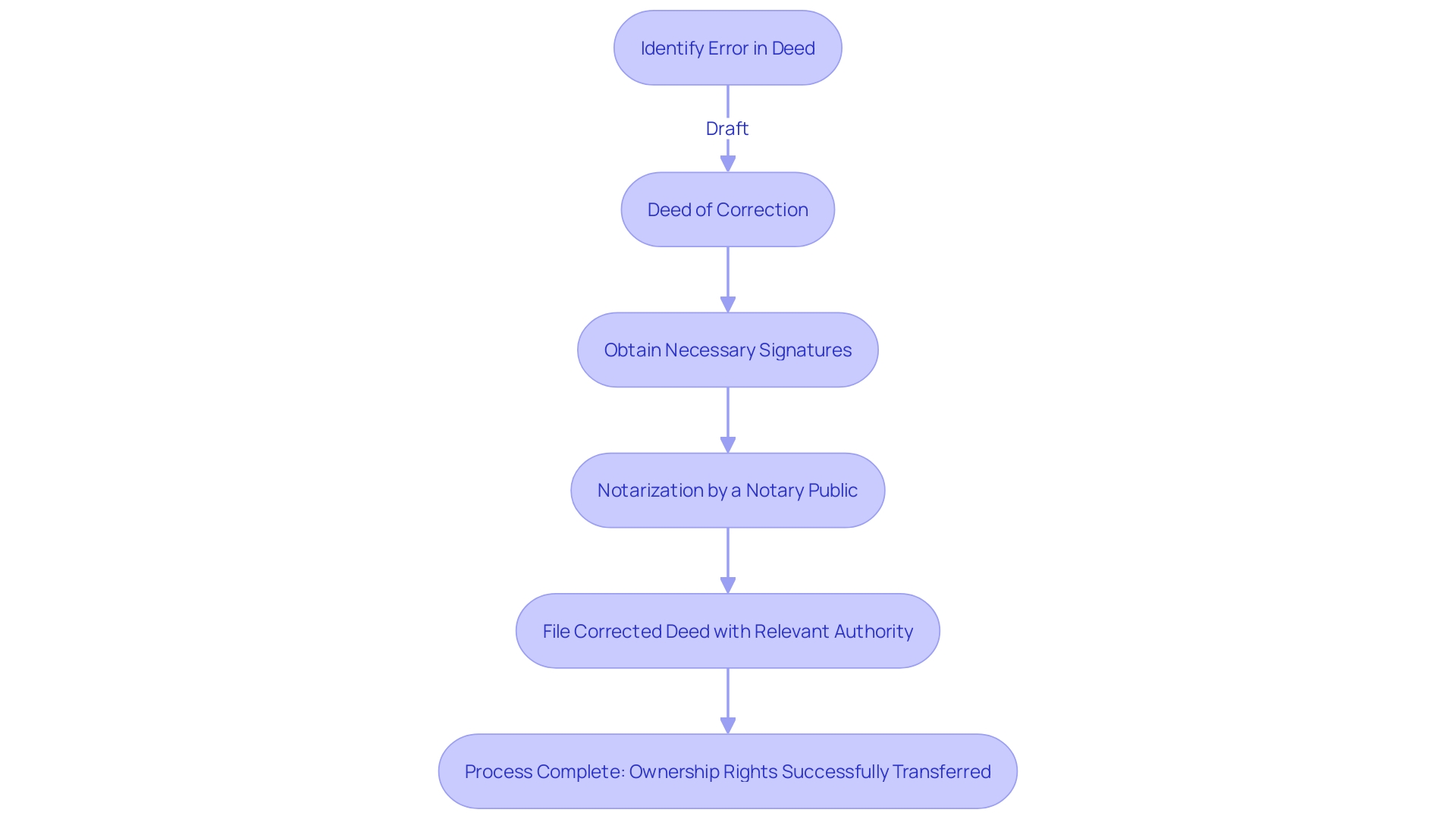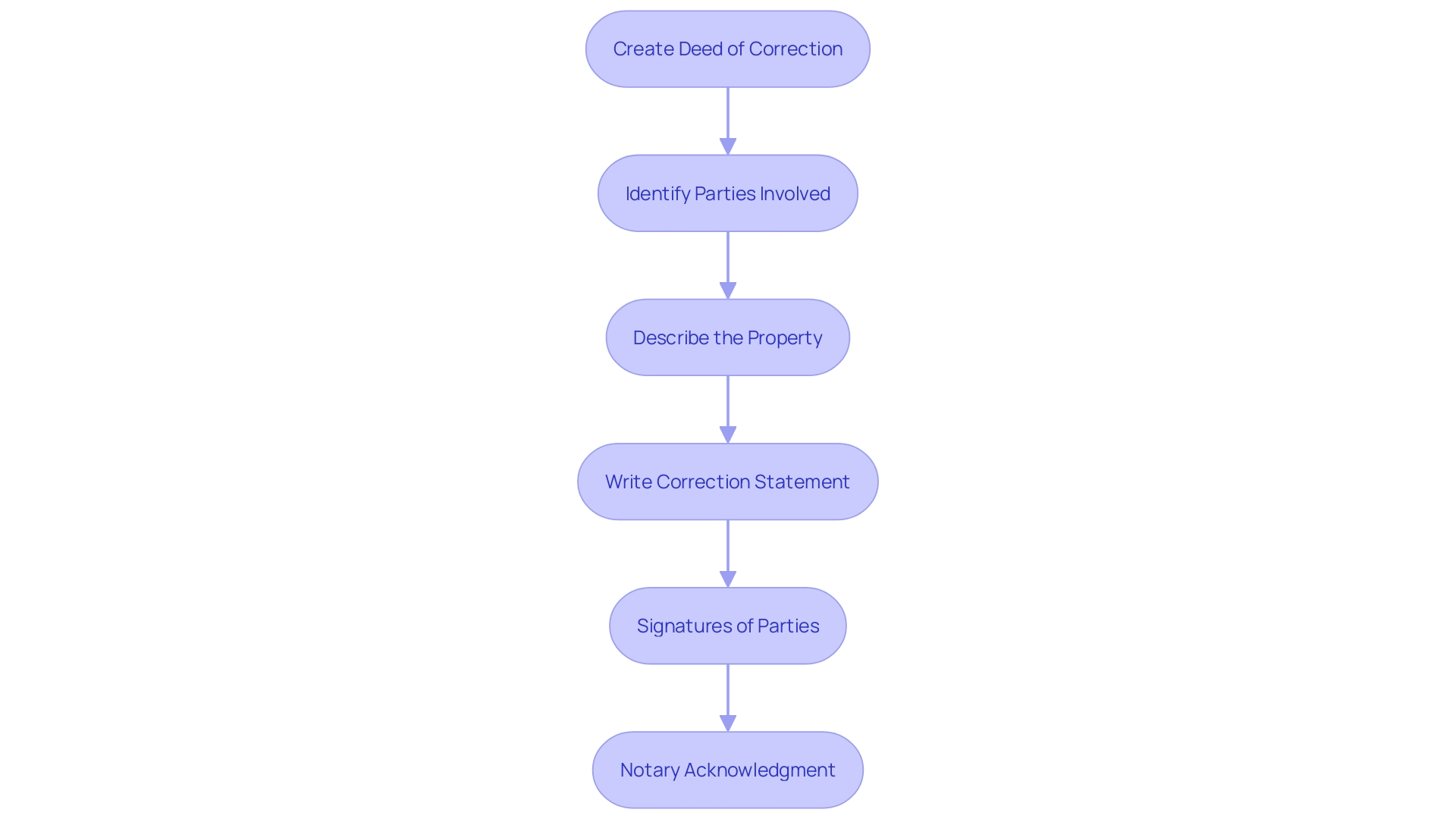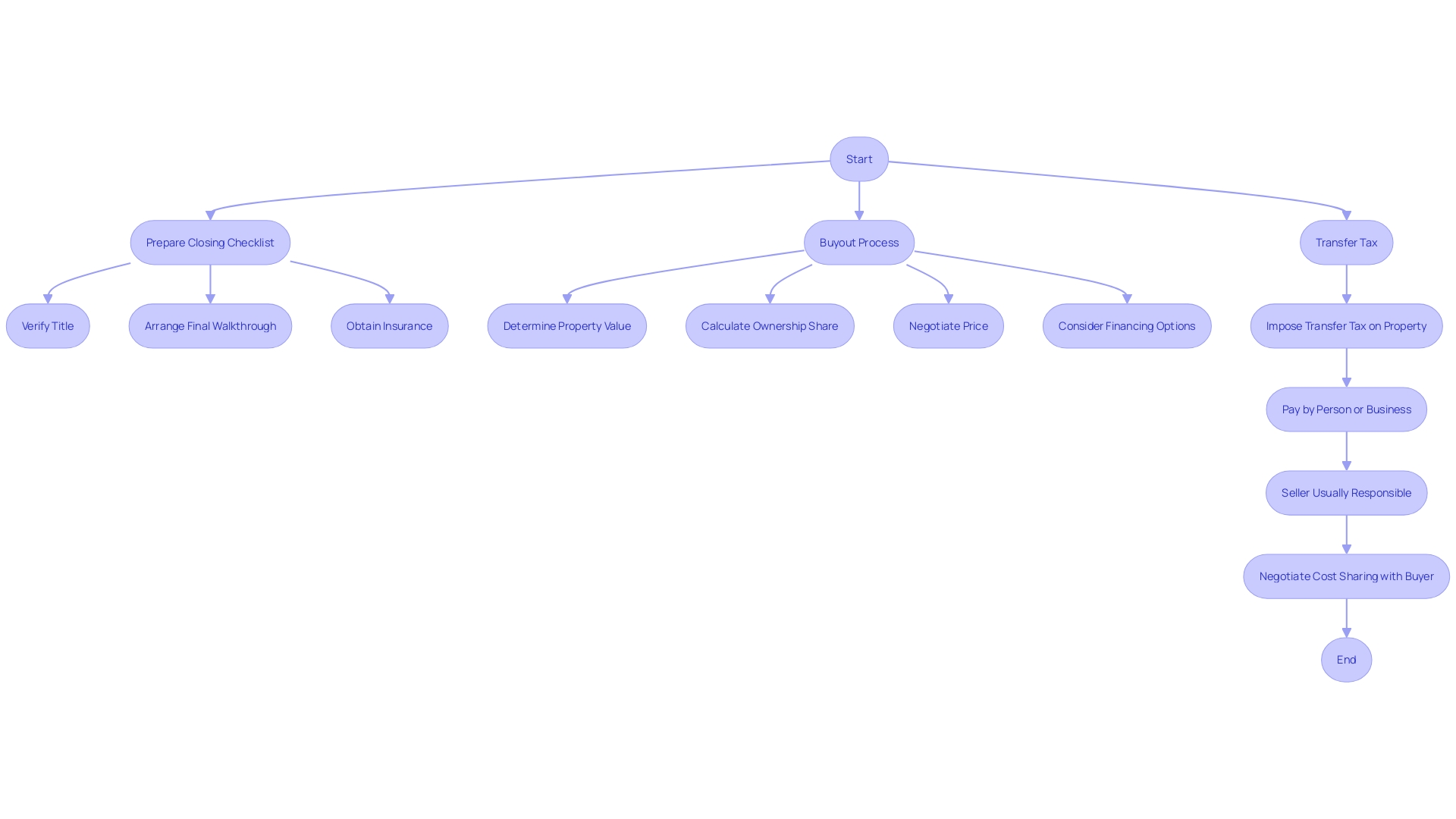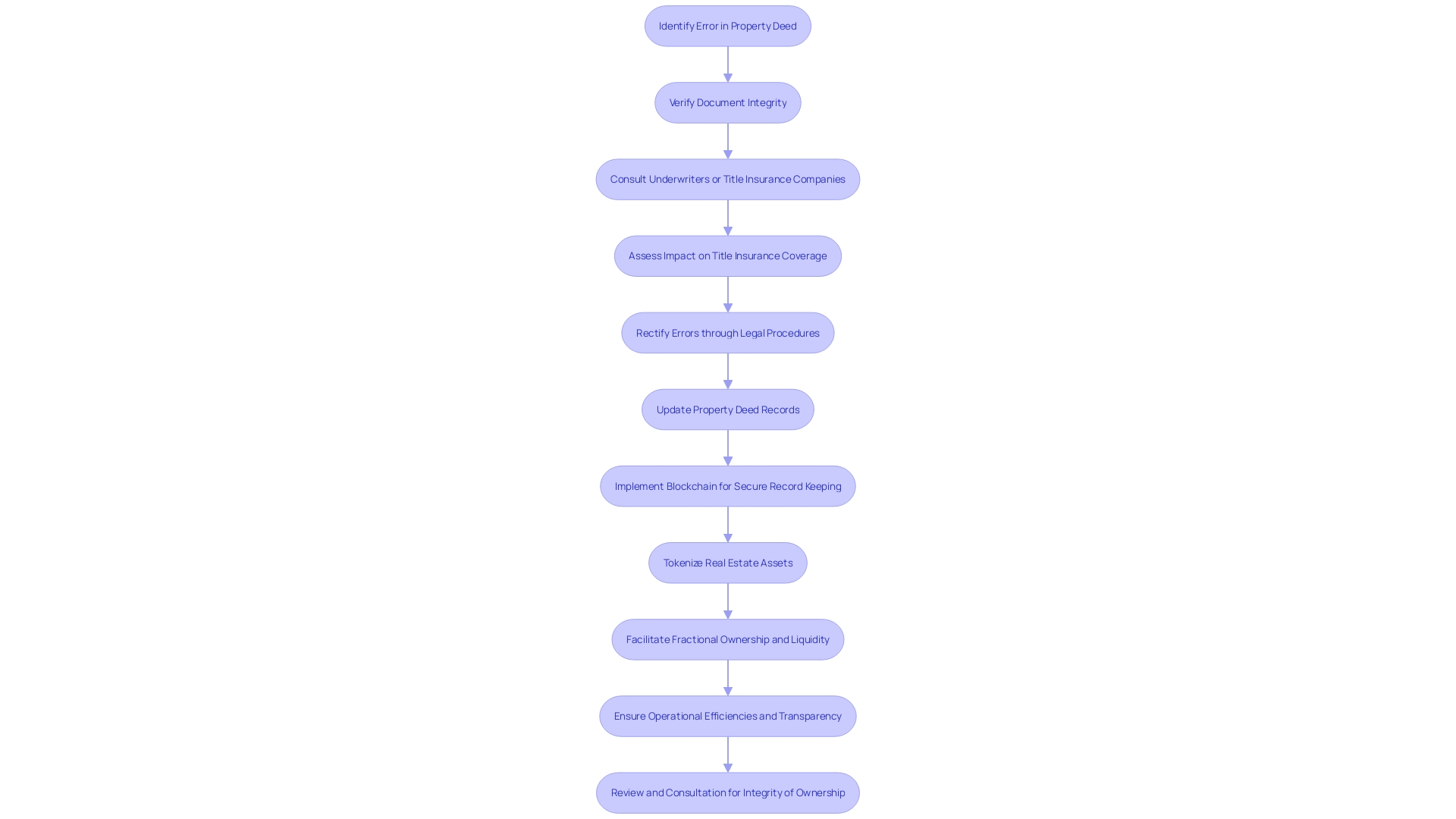Introduction
When it comes to property transactions, accuracy and attention to detail are of utmost importance. Errors in deeds can lead to legal complications and disputes. That's where a Deed of Correction comes into play.
This legal instrument is used to rectify mistakes in a previously recorded deed, ensuring that all details, such as property descriptions and ownership information, are accurate and legally sound. In this article, we will explore the types of errors that may require a Deed of Correction, the process of creating and recording one, common examples of errors in deeds, the components of a Deed of Correction, and the difference between a Deed of Correction and a Scrivener's Affidavit. We will also discuss the potential risks and complications involved in correcting deeds and the state-specific rules and considerations that must be taken into account.
By delving into these topics, we aim to provide authoritative and knowledgeable information to the Director of Title Research, ensuring a thorough understanding of the importance and intricacies of Deeds of Correction in property transactions.
Types of Errors Corrected by Deed of Correction
When a deed is created, it's essential to have all the details correct to avoid future legal complications. However, errors can occur, and when they do, a is the tool used to rectify such mistakes. Common errors that may necessitate a Deed of Correction include misspelled names of the parties involved, inaccurate property descriptions, and omissions or mistakes in the .
A deed is a pivotal legal document in as it provides proof of ownership. It outlines the grantor (the seller) and the grantee (the buyer), along with a physical description of the property. Moreover, there are various types of deeds, each offering different levels of protection and warranties to the buyer.
are well aware that the is paramount, as it is the document that transfers ownership from one party to another. The complication of mortgage deeds adds to the importance of precision, as they involve a lien on the property that only dissolves once the mortgage is fully paid.
Real estate laws have grown increasingly complex. A century ago, federal statutes could fit into a single volume, whereas today, they span over 54 volumes. This complexity underscores the need for meticulous attention to detail when drafting, reviewing, and correcting deeds.
In the context of a rapidly evolving real estate sector, blockchain technology is emerging as a promising tool to streamline . Countries like Israel and Nigeria are exploring ways to apply blockchain for property registration, license management, and even real estate tokenization. This innovation could lead to more efficient, transparent, and secure processes, potentially reducing the frequency of errors that necessitate correction deeds.
Statistics show that while a significant percentage of millennials and zoomers aim to purchase homes, financial barriers often prevent them from achieving this goal. This highlights the importance of ensuring that every step in the property transaction process, including the accuracy of deeds, is handled with the utmost diligence to avoid further financial strain or legal disputes.
With the intricate and extensive body of laws governing real estate, it's clear that the is crucial. By correcting errors, it maintains the integrity of property transactions and upholds the legal rights of the owners involved.

Common Examples of Errors in Deeds
Understanding the intricacies of Deed Corrections is pivotal in the realm of . A Deed of Correction is a legal instrument used to rectify mistakes in a previously recorded deed, ensuring that property descriptions and ownership details are accurate and legally sound. Common errors that necessitate such corrections can range from simple typographical blunders in names to more complex inaccuracies in property descriptions or omissions of necessary signatures.
For instance, a deed may erroneously omit a necessary signature or contain an incorrect notary acknowledgment. Such seemingly minute details can have significant ramifications, leading to legal disputes or challenges in . By identifying and addressing these issues promptly, the integrity of property records is maintained, safeguarding the interests of all parties involved.
Moreover, a recent case highlighted the gravity of accurate property documentation when a Black couple's home in Baltimore was undervalued due to alleged racial bias. The settlement of this lawsuit underscored the necessity for vigilance and corrective actions in property appraisals and descriptions. Similarly, the Briggs petition to the Supreme Court for a name change in a historic desegregation case illustrates the enduring impact of precise legal documentation.
In light of these concerns, it's crucial for to stay abreast of changes in cadastral services and digitalization efforts, as evidenced by the implementation of private cadastral engineers in Tashkent, Uzbekistan. Such advancements in land registration and mapping are essential for the accurate and efficient correction of deeds.
When , it is essential to have a thorough understanding of the property's legal description and the parties involved. The deed should clearly state the grantor and grantee's details, and any limitations or guarantees associated with the property must be meticulously reviewed. This diligence ensures that property ownership rights are correctly transferred and protected, reinforcing the significance of precise and thorough title research in the real estate industry.
Process of Creating and Recording a Deed of Correction
When correcting a deed, precision and are paramount. The process begins with pinpointing the exact error within the original deed. This could range from a misspelled name to an incorrect . Following this, a is meticulously drafted, outlining the correct information and referencing the initial deed's details, such as the property description and the identities of the grantor and grantee.
Subsequent to the preparation of the document, all relevant parties must manifest their agreement to the corrections by affixing their signatures. To further solidify the document's authenticity, it is essential for the Deed of Correction to be , which serves as an official endorsement of the document's validity.
The culminating step in the process is to file the Deed of Correction with the corresponding county or legal jurisdiction where the original deed was recorded. This crucial action ensures that the rectification is formally acknowledged and integrated into the public record, thus maintaining the integrity and continuity of property ownership information.
This series of steps ensures the legal efficacy of the Deed of Correction, thereby safeguarding the interests of all parties involved and reinforcing the accuracy of the property's historical record. In the complex and detail-oriented realm of property transactions, such meticulous processes are indispensable for rectifying any errors and ensuring the seamless transfer of ownership rights.

Components of a Deed of Correction
The precision of a is paramount in the realm of , as it serves to amend any inaccuracies found in the original deed. This document must be constructed with , ensuring its validity and enforceability. It begins with a clear heading, affirming its purpose as a Deed of Correction. Identification of all parties is crucial, including the original grantor and grantee, along with any others entangled in the correction process. A comprehensive and precise description of the property in question is essential, leaving no room for ambiguity.
A critical element of the Deed of Correction is the Correction Statement. This part explicitly conveys the errors identified and articulates the rectified details with unambiguous accuracy. Signatures of all involved parties are a must, as they symbolize the collective acknowledgment and ratification of the corrected information. Lastly, the Notary Acknowledgment serves as the seal of authenticity, with a notary public confirming the legitimacy of the signatures.
The significance of each component cannot be overstated, as they collectively fortify the Deed of Correction, transforming it into a that ensures the integrity of property records. This meticulous approach to correcting property deeds is reflective of the evolving landscape of real estate, where traditional procedures intersect with modern technological advancements, such as the tokenization of real-world assets on blockchain networks.
In an era where technology is reshaping the foundation of property ownership and transfer, the Deed of Correction stands as a testament to the enduring importance of accuracy and legal formality. Its components, structured with intention and precision, echo the complex interplay of historical property rights and digital innovation, ensuring that every correction is a step towards clarity and confidence in real estate transactions.

Difference Between Deed of Correction and Scrivener’s Affidavit
A Scrivener's Affidavit is a legal instrument used to address and rectify clerical mistakes in a property deed, such as typographical errors or minor omissions. This affidavit is a declaration made under oath by the individual who drafted the original deed, stating the error and the intended correct information. The key advantage of a Scrivener's Affidavit lies in its simplicity; it does not necessitate re-execution by the parties to the original deed, making it a streamlined solution for correcting non-material errors that do not alter the fundamental terms or legal effectiveness of the deed itself.
The distinction between a and a Scrivener's Affidavit is particularly relevant in the face of legal precedents that emphasize the importance of clear and accurate documentation in property disputes. Courts often rely on the intent and conduct of the parties involved, as evidenced in the property records, to resolve ownership issues. In cases where discrepancies arise, such as a misstated property boundary or incorrect name spelling, the Scrivener's Affidavit serves as an essential tool to confirm the true intentions of the parties, without the need for a more formal, and often more cumbersome, Deed of Correction.
Recent legal developments and market shifts underscore the critical nature of accurate real estate documentation. With high-value transactions and the potential for significant legal ramifications, including the alteration of beneficial interests or the distribution of financial liabilities, the precision afforded by a Scrivener's Affidavit can prevent costly legal challenges. For example, the recent ruling that could disrupt traditional real estate commission structures highlights the intricacies of property transactions and the dire consequences of document inaccuracies.
In this landscape, where even a simple clerical error can lead to substantial disputes or a misunderstanding of ownership stakes, the role of the Scrivener's Affidavit becomes increasingly important. It provides a swift and legally recognized means to affirm the true agreement between parties, thereby maintaining the integrity of property transactions and supporting the stability of the real estate market.
Timelines and Filing Requirements for Deed of Correction
Navigating the intricacies of is a multi-faceted process that demands a deep understanding of and adherence to specific regional practices. A critical component of this process involves the , which rectifies any inaccuracies in the original deed. The procedures for submitting a [Deed of Correction](https://blog.parseai.co/understanding-deed-of-trust-vs-warranty-deed-an-in-depth-tutorial-for-real-estate-professionals), including timelines and documentation, may differ by jurisdiction, and it is imperative to be well-versed in the local requirements.
- Timelines: Jurisdictions may impose certain deadlines for filing a Deed of Correction post the recording of the original deed. Non-compliance with these deadlines could invalidate the correction.
- Filing Fees: Submission of a Deed of Correction typically incurs filing fees, which are subject to change based on the locality. Forecasting these costs is essential for a seamless correction process.
- Documentation: A successful submission often requires additional documentation, such as the original deed and related affidavits, to support the corrections made.
The deed itself is a testament of ownership, encapsulating vital details about the grantor, grantee, precise property descriptions, and other salient information. Real estate transactions, whether adding a new owner due to marriage or transferring ownership through sale, necessitate a title search to confirm the rightful owner and reveal any liens or encumbrances. Consequently, practitioners must ensure that the transfer adheres to the guiding principles of being in writing, distinctly identifying the parties involved with legal names, and clearly specifying the property with an accurate address and legal description.
Continuous expansion of regulations, such as the proposal by FinCEN, underscores the importance of reporting and transparency in real estate transactions. These evolving rules, which now encompass properties of all values and are applicable to various ownership transfers, highlight the significance of meticulous compliance and reporting in the real estate sector.
Understanding these elements is paramount for professionals who are responsible for maintaining the integrity of , ensuring legal compliance, and facilitating the rightful transfer of property ownership.

Potential Risks and Complications in Correcting Deeds
Rectifying errors in is a delicate task that carries the weight of ensuring legal ownership and avoiding disputes. When a deed requires amendments, a is utilized to make necessary corrections. However, this process is not without its challenges and complexities. Amending a deed can sometimes lead to questioning the legitimacy of the original document, as seen in the case where a will's ambiguous language regarding a man's heirs led to unexpected interpretations and potential legal disputes highlighted by the law firm And skin and Ricaforte. Similarly, when adding or altering information on a deed, there's a risk of introducing new errors, which makes meticulous verification of the corrections essential.
Moreover, a Deed of Correction can influence the status of one's . It's prudent to consult with an underwriter or a title insurance company to assess its impact on your policy. The real estate market, as noted by First American Financial Corporation, is continuously evolving, and title insurance plays a pivotal role in protecting stakeholders in real estate transactions. The intricacies of , whether through inheritance, marriage, or partnership, further underline the critical nature of accurate property deeds.
In the digital age, blockchain technology offers enhanced transparency and security in property transactions. Its decentralized nature and cryptographic security are transforming how transactions are recorded, as explained in the context of tokenized real estate assets. Yet, the integration of traditional real estate with digital tokens brings forth unique risks, such as technological failures or fraudulent actions, emphasizing the importance of clear contractual agreements between property owners and token holders.
Ultimately, recognizing and mitigating potential complications during deed corrections is fundamental to safeguarding property ownership and maintaining the integrity of the title. The process demands a detailed understanding of legal procedures, vigilant review of documents, and, when necessary, professional consultation to navigate the complexities of real estate transactions effectively.

State-Specific Rules and Considerations
When dealing with , it's imperative to recognize that each state has its own set of rules and standards that dictate the format, substance, and procedure for filing. For instance, a deed not only proves ownership but also contains crucial details about the property and its history. Missteps in the correction process can lead to legal complications or even invalidate the correction itself. Therefore, , engage with legal counsel, or rely on official resources to gain accurate and current insights.
The nuances of property transfer, like conducting a thorough title search to verify ownership and identify any liens, are foundational to understanding why precision in correction deeds is vital. The recent , particularly within the Business and Professions Code and other relevant sections, underscore the importance of staying current with legislation affecting real estate practices.
Moreover, the intricacies of different deed types can greatly influence the level of protection a buyer may receive, which is why is essential. As the legal landscape evolves, as evidenced by changes in statutes and the adoption of more efficient legal practices, such as paperless Law Offices and regular communication updates, title researchers need to adapt their methods to maintain compliance and facilitate clear property ownership transfers.
Conclusion
In conclusion, a Deed of Correction is a crucial legal instrument used to rectify errors in property deeds, ensuring accurate and legally sound information. It addresses common errors such as misspelled names, inaccurate property descriptions, and omissions or mistakes in legal details.
Creating and recording a Deed of Correction involves a precise process, including identifying the error, drafting the correction document, obtaining signatures, and notarizing the document. Filing the Deed of Correction with the appropriate jurisdiction maintains the integrity of property ownership records.
The components of a Deed of Correction, such as clear headings, identification of parties, comprehensive property descriptions, correction statements, signatures, and notary acknowledgments, fortify the document's validity and accuracy.
Differentiating between a Deed of Correction and a Scrivener's Affidavit is crucial. The latter addresses clerical mistakes without altering the fundamental terms of the deed, providing a streamlined solution.
Complying with state-specific rules, timelines, filing requirements, and documentation is essential for a seamless correction process. Staying up-to-date with local requirements ensures accurate and compliant procedures.
Although correcting deeds carries risks and complications, meticulous verification and considering the impact on title insurance coverage can mitigate issues. The integration of blockchain technology in property transactions presents unique risks that require clear contractual agreements.
In summary, Deeds of Correction maintain the accuracy and legality of property transactions. Professionals in title research play a vital role in facilitating clear and confident property ownership transfers, ensuring the integrity of property records and upholding the legal rights of owners involved.
Frequently Asked Questions
What is a Deed of Correction?
A Deed of Correction is a legal document used to correct errors in a previously recorded deed, ensuring property descriptions and ownership details are accurate and legally sound.
Why might a Deed of Correction be necessary?
Common reasons include misspelled names, inaccurate property descriptions, and omissions or mistakes in the legal description of the property.
What are some common types of errors in deeds?
Errors can range from typographical mistakes in names, incorrect property descriptions, omissions of necessary signatures, to incorrect notary acknowledgments.
How does a Deed of Correction differ from a Scrivener's Affidavit?
A Scrivener's Affidavit is used for clerical mistakes and does not require re-execution by the original parties, whereas a Deed of Correction is for more substantial errors that may affect legal terms or effectiveness.
What is the process for creating and recording a Deed of Correction?
The process involves identifying the error, drafting the Deed of Correction with correct details and references to the initial deed, obtaining signatures from relevant parties, notarization, and finally filing with the appropriate legal jurisdiction.
What are the key components of a Deed of Correction?
Key components include a clear heading, identification of all parties involved, a precise property description, a correction statement detailing the errors and corrections, signatures of all parties, and a notary acknowledgment.
Are there specific timelines and filing requirements for a Deed of Correction?
Yes, jurisdictions may have different deadlines and requirements for filing a Deed of Correction, which could include certain filing fees and additional supportive documentation.
What are the potential risks and complications in correcting deeds?
Risks include questioning the legitimacy of the original deed, introducing new errors, impacting title insurance coverage, and potential legal disputes.
How has technology affected the process of correcting deeds?
Blockchain technology is emerging as a tool to streamline property transactions, offering more efficient, transparent, and secure processes that could reduce errors.
Why is it important to consider state-specific rules when dealing with Deeds of Correction?
Each state has its own rules and standards that dictate the process for correcting deeds. Missteps can lead to legal complications or invalidate the correction, so it's important to consult state statutes and legal counsel.




